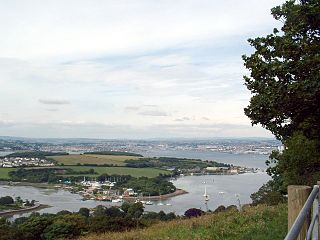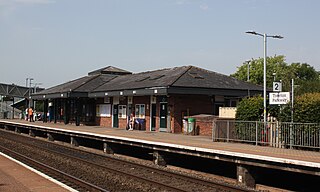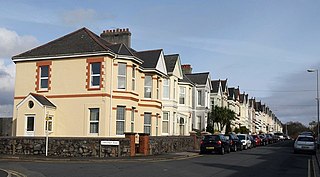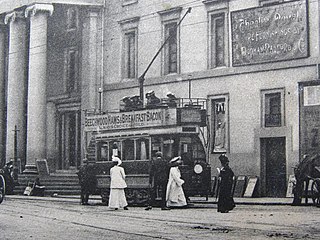Peverell is a neighbourhood of Plymouth in the English county of Devon.
Contents
Peverell may also refer to:
Peverell is a neighbourhood of Plymouth in the English county of Devon.
Peverell may also refer to:

Devon is a ceremonial county in South West England. It is bordered by the Bristol Channel to the north, Somerset and Dorset to the east, the English Channel to the south, and Cornwall to the west. The city of Plymouth is the largest settlement, and the city of Exeter is the county town.

The Hamoaze is an estuarine stretch of the English tidal River Tamar, between its confluence with the River Lynher and Plymouth Sound.
Plymouth is a city in Devon, England.
Janner is an English regional nickname associated with Plymouth both as a noun and as an adjective for the local accent and dialect. In 1987 Cyril Tawney, in his book Grey Funnel Lines, described its meaning as "a person from Devon", deriving from Cousin Jan, but "more particularly in naval circles anyone from the Plymouth area". The term was also used for members of the Devonshire and Dorset Regiment.

Tiverton Parkway railway station is on the Bristol to Exeter line in Devon, England. Despite being named after the town of Tiverton it is actually located in the civil parish of Burlescombe, near Sampford Peverell, 6 miles (9.7 km) to the east of Tiverton, and close to the junction of the M5 motorway with the A361 North Devon link road. It is 177 miles 28 chains from the zero point at London Paddington via Bristol Temple Meads.

Peverell is a neighbourhood of Plymouth in the English county of Devon. The 2001 Census estimated the population as 6,455, increasing dramatically to 13,553 at the 2011 census.

Sampford Peverell is a village and civil parish in Mid-Devon, England. An old Saxon settlement, it was called Sanforda in the 1086 Doomsday Book. Its current name reflects its inclusion in the Honour of Peverel, the lands of William Peverel and his family. His great-grandson, Hugh Peverell, is buried in the village church of St John the Baptist. The Grand Western Canal cuts through the village.
St Boniface's Catholic College is a secondary school for boys, under the direction and trustees of the Roman Catholic Community in the Plymouth area in the South West of England. Founded in 1856 as an independent boarding and day school for "young Catholic gentlemen" in the West Country, it is now a comprehensive school. The College is named for St Boniface who was born in Crediton, Devon and is the patron saint of Germany. The school has a list of distinguished former pupils including Air Chief Marshal Sir John Gingell GBE KCB KCVO, the writer and intelligence agent Alexander Wilson, and Sir Julian Priestley KCMG, Secretary General of the European Parliament from 1997 to 2007.
Robert fitz Martin was a knight from Devon whose father, Martin de Turribus, was the first Norman Lord of Kemes, in what had previously been the Dyfed part of Deheubarth. Fitz Martin inherited the Lordship of Kemes from his father, and founded St Dogmaels Abbey c. 1118. He was the first of the FitzMartin line. His descendants continued to hold lands in England and Wales until the 14th century.
Ham is a post-war suburb of Plymouth in the county of Devon, England. The population of the ward taken at the 2011 census was 13,294.
William "the Younger" Peverel was the son of William Peverel. He married Avicia de Lancaster in La Marche, Normandy, France. She was possibly the daughter of William de Lancaster I and Countess Gundred de Warenne, daughter of William de Warenne, 2nd Earl of Surrey. In 1114, she bore a daughter, Margaret Peverel. Another member of his family, Maude Peverel was, by 1120, the first wife of Robert fitz Martin.
Sport in Plymouth, Devon, England, dates back to the 19th century with its first club, Plymouth United F.C., being founded in 1886. It is the largest city in England never to have had a football team in the first tier of English football. It is home to Plymouth Argyle Football Club, who play in the Football League One at the Home Park stadium in Central Park. It is Plymouth's only professional football team, however the city used to have another team called Plymouth United F.C. dating back to 1886. The club takes its nickname from the group of English non-conformists that left Plymouth for the New World in 1620: the club crest features the Mayflower, which carried the Pilgrims to Massachusetts and the club's mascot is named Pilgrim Pete.
William the Younger may refer to:
Peverell Park was a cricket ground in Plymouth, Devon. The ground was located close to Plymouth Argyle's home ground, Home Park.
Jed Ethan Patrick Harper-Penman is an English footballer who plays for Barnstaple Town as a winger.
Hele, Hélé, or Hèle may refer to:

The tramways in Plymouth were originally constructed as four independent networks operated by three different companies to serve the adjacent towns of Plymouth, Stonehouse and Devonport in Devon, England. The merger of the 'Three Towns' into the new borough of Plymouth in 1914 was the catalyst for the three companies to join up under the auspices of the new Plymouth Corporation. The network was closed in 1945, partly as a result of bomb damage during World War II.
Peverel can refer to:
Peverill is a surname and given name of Old French origin, a variant of the surname Peverall, which means 'little pepper'. Notable people with the surname include: